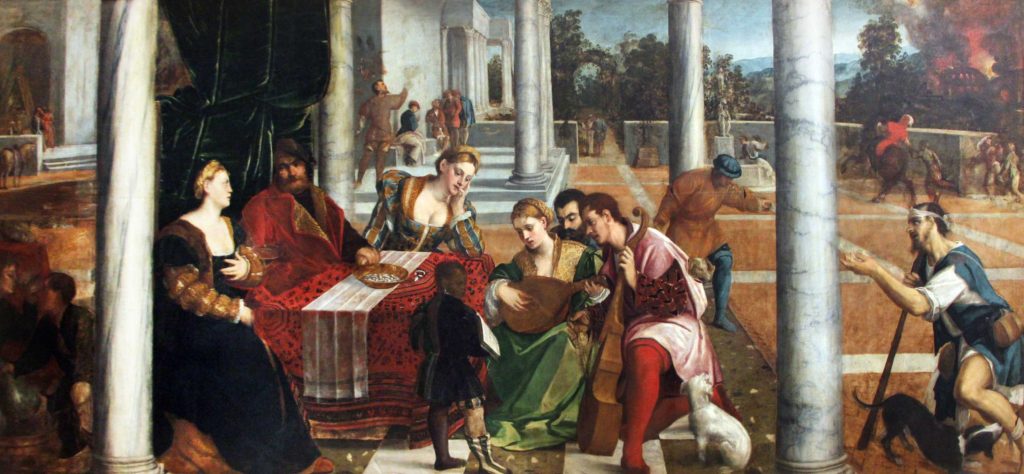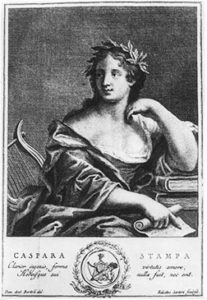Gaspara Stampa (1523-1554) translations from RIME (Rhymes)
Translations and this article both © 2016 by Chris DiMatteo. All rights reserved.

Here are my English translations of two sonnets by Gaspara Stampa, the most renowned Italian woman poet of her time and one of the most skilled and interesting poets ever, regardless of gender. Her collection of 311 RIME (Rhymes) is an eloquent and deeply personal emotional autobiography. Her sister Cassandra published them in 1554 right after Gaspara’s untimely death at the age of 31.
She addresses other women directly in her writing: in Rime, number I, at line 9, “E spero ancor che debba dir qualcuna” (I hope some lady will see fit to say); in the first line of N. VII… “Chi vuol conoscer, donne, il mio signore” (Ladies, if you wish to know my lover) and in the first line of N. LXXXVI, “Piangete, donne, e con voi pianga Amore (Cry, ladies, and Amore cries with you). She also addressed other women directly in her life as a poet, musician and singer in the very lively city of Venice of the early to mid 1500s.
Gaspara Stampa as a Musician
Gaspara Stampa was famous for her music as well as her poetry, during her short life. She wrote and played songs but sadly only her reputation as a singer and lutenist has been preserved, and none of her music. In the painting below, I believe that is Gaspara Stampa in the middle playing the lute with her sister Cassandra at the table behind her. They sure look the part. Gaspara Stampa and the painter, Bonifazio de’Pitati, were contemporaries in Venice and she was well known as a musician. I believe I have made this discovery, as I have searched the academic literature on poetry as well as art history and have found no evidence of anyone else identifying her here. I first published this idea here in October 2016 and to this date have not found any reference to this in previous writing on the subject.

“Il convitto del ricco epulone” by Bonifazio de’Pitati, a.k.a. Bonifazio Veronese, in the Gallerie dell’Accademia in Venice. The title means “The Banquet of the Wealthy Epulone” and depicts the biblical story of the rich man and Lazarus.
My translation of Rime (Rhymes) N. I
O you who hear these melancholy rhymes
my dismal, sad and blue accented gloom,
the sound of these my amorous laments,
and o my woes the greatest of these all,
Wherever t’is that valor is most prized
Glory, also pity for my pain,
I hope to hear from you, my well-born friends,
That I lament for reasons so sublime.
I hope some lady will see fit to say
-You happy woman that you can hold up
against such woes and with such clear intent!
Well, I would wish that fortune, such a love,
for such a noble lord, would come to me,
that even I, that way, could be her peer.
Here is the original of N. I by Gaspara Stampa:
Voi, ch’ascoltate in queste meste rime
in questi mesti, in questi oscuri accenti
il suon degli amorosi miei lamenti
e de le pene mie tra l’altre prime,
ove fia che valor apprezzi e stime,
gloria, non che perdon, de’ miei lamenti
spero trovar fra le ben nate genti,
poi che la lor cagione è sì sublime
E spero ancor che debba dir qualcuna:
-Felicissima lei, da che sostenne
per sì chiara cagio danno ì chiaro!
Deh, perché tant’amor, tanta fortuna
per sì nobil signor a me non venne,
ch’anch’io n’andrei con tanta donna a paro?
My translation of Rime (Rhymes) N. VII
 Ladies, if you wish to know my lover,
Ladies, if you wish to know my lover,
Imagine someone strong and sweet to see,
Young in years and yet of wisdom older,
His glory and his valor there for me,
A fair-haired youth of lively colored gaze,
And standing tall and broadly in his chest,
For me a perfect man in many ways
who sadly, has refused to build my nest.
And if you will know me, I’ll have you see
a woman in effect who carries all
the image of my martyrdom and death
A sanctuary of my constant faith
And so although I cry and burn and sigh,
No pity does my cruel lover feel.
Here is the original of N. VII by Gaspara Stampa:
Chi vuol conoscer, donne, il mio signore,
miri un signor di vago e dolce aspetto,
giovane d’anni e vecchio d’intelletto,
imagin di la gloria e del valore;
di pelo biondo, e di vivo colore,
di persona alta e spazioso petto,
e finalmente in ogni opra perfetto,
fuor ch’un poco (oimè lassa!) empio in amore.
E chi vuol poi conoscer me, rimiri
una donna ineffetti ed in sembiante
imagin de la morte e de’ martiri,
un albergo di fé salda e costante,
una, che, perché pianga, arda e sospiri,
non fa pietoso il suo crudel amante.
Gaspara Stampa Sings the Blues
Garpara Stampa lived four centuries too early to hear Ma Rainey, Bessie Smith and Billie Holiday but she and those twentieth century ladies are singing the same song. Gaspara Stampa was singing the blues, four hundred years before they were ever heard. Compare her laments to the lyrics that Billie Holiday wrote for her song “Fine and Mellow,” a blues song where she also wrote the music:
My man don’t love me, treats me oh so mean,
My man don’t love me, treats me awful mean,
He’s the meanest man, that I’ve ever seen. (etc.)

Raffaello Sanzio, Madonna Sistina, Vatican Museum (detail from the bottom of the painting).
